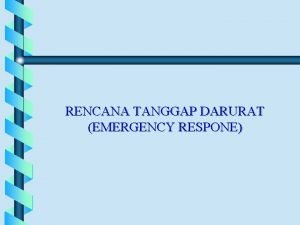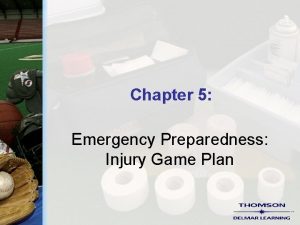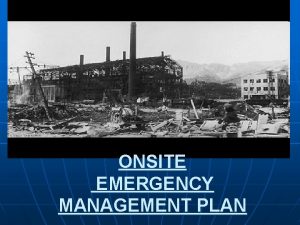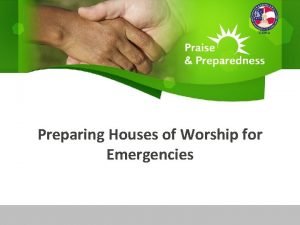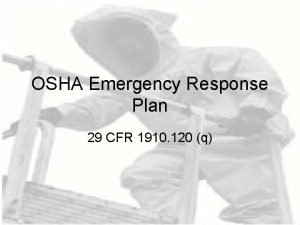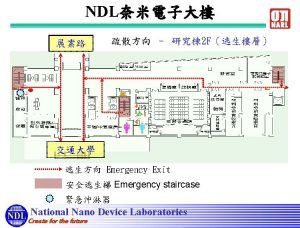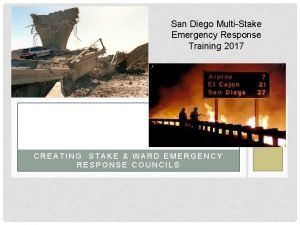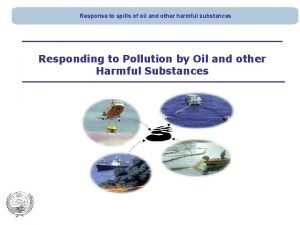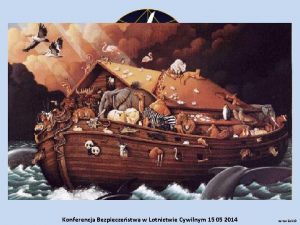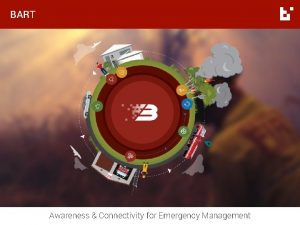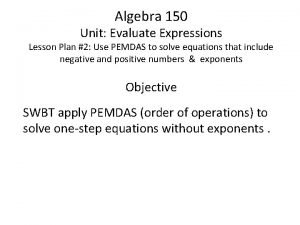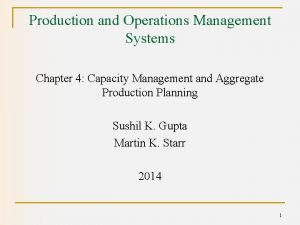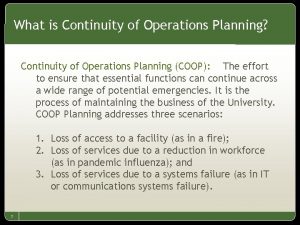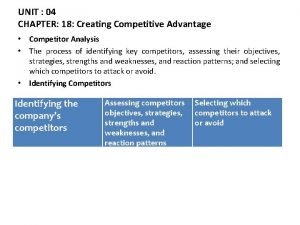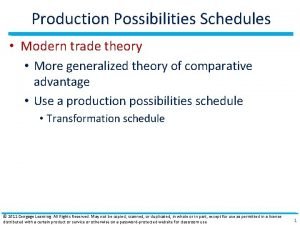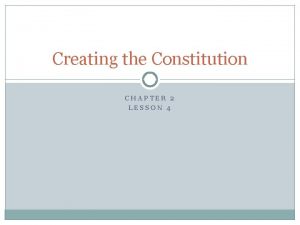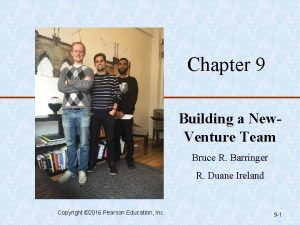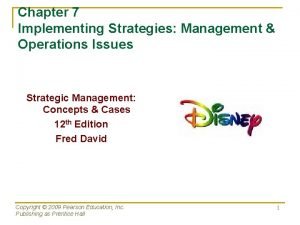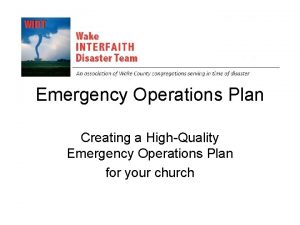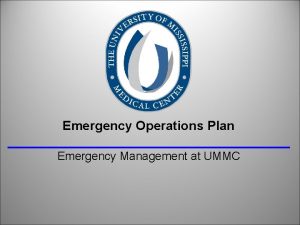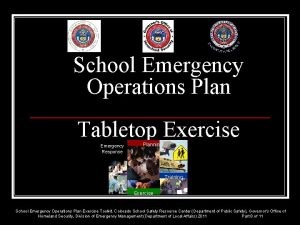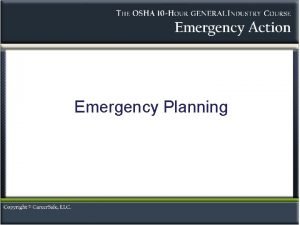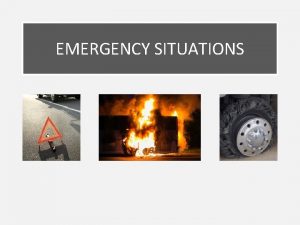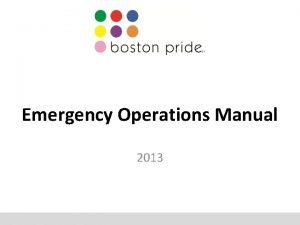Emergency Operations Plan Creating a HighQuality Emergency Operations







































- Slides: 39

Emergency Operations Plan Creating a High-Quality Emergency Operations Plan for your church

Agenda • • • Welcome and Introduction Types of Disaster Planning Process Caring for Congregants Staying prepared

Wake Interfaith Disaster Team • Formed in 2002 • Primary goal – Serving unmet needs in long-term recovery phase • Secondary goals – Fostering development of congregation teams – Training volunteers for response phase – Preparation/Mitigation • Coordinated recovery: 2011 tornados • NC Baptist Men were key partners

Phases of Disaster

Preparing an Emergency Plan • No universal plan • Different risks/hazards at each facility • Can you name some? – Trees near building – Flash flooding – Others? • Tools to make a plan

Your Planning Team • Need a team to develop the EOP – Administrator/Facilities chair/Board Member • Leads plan development – Ministers/Teachers/Ushers • Direct the response – Why? • • Administrator has time, knows building and hazards Minister/teacher present when crowd is present Minister on pulpit with microphone, commands respect Minister/teacher looked to as authority

Consequences of Diverse Team • Everyone must buy in • Everyone must be prepared to execute the plan • Why? – Knowledgeable leader/teacher might not be present • Regular practice – Tabletop exercise at every staff meeting? – Live Drills? Tornado or fire drill in religious school?

Agenda • • • Welcome and Introduction Types of Disaster Planning Process Caring for Congregants Staying prepared

Wake County Hazards • • • Hazmat release Hurricane Public Health Flood Winter Storm Tornado Wild Fire School Violence Fire • • Criminal Act Drought Earthquake Train Derailment Airplane Accident Civil Disorder Severe Weather Utility Failure

Other Hazards • Cyber Events • Medical Emergency (Asthma, seizure, cardiac problems) • Severe Weather (SIP, cancel services) • Burglary, Theft, Vandalism • Disturbance (argument, threats) • Gas odor, smoke odor …

Response Plan to stay Plan to go

Hazard Responses • Plan to Stay • Plan to Go • Shelter In Place • Evacuate – – Tornado Hazmat outside Utility outage Lightning – – – • Plan to Restrict • Lockdown Fire Flood Hazmat in bldg Bomb threat Tsunami Gas leak – – Intruder Suspicious person Dangerous person Active shooter

Agenda • • • Welcome and Introduction Types of Disaster Planning Process Caring for Congregants Staying prepared

Planning Principles • • Supported by leadership Consider all threats and hazards Consider all settings and all times Provides for the access and functional needs of the whole house • Follows a collaborative process

The Process in 6 Steps 1. 2. 3. 4. 5. 6. Form collaborative planning team Understand the situation Determine goals and objectives Identify courses of action Plan preparation, review and approval Plan implementation and maintenance

The Process in 6 Steps 1. 2. 3. 4. 5. 6. Form collaborative planning team Understand the situation Determine goals and objectives Identify courses of action Plan preparation, review and approval Plan implementation and maintenance

Understand the Situation • • • Probability or frequency Magnitude (extent of damage) Time available to warn occupants Duration Follow-on effects

Worksheet Example Hazard Probability Magnitude Warning Duration Risk Priority Earthquake 4. Highly likely 3. Likely 2. Possible 1. Unlikely 4. Catastrophic 3. Critical 2. Limited 1. Negligible 4. Minimal 3. 6 -12 hours 2. 12 -24 hrs. 1. > 24 hrs. 4. 12+ hours 3. 6 -12 hours 2. 3 -6 hours 1. < 3 hours High Medium Low Fire 4. Highly likely 3. Likely 2. Possible 1. Unlikely 4. Catastrophic 3. Critical 2. Limited 1. Negligible 4. Minimal 3. 6 -12 hours 2. 12 -24 hrs. 1. > 24 hrs. 4. 12+ hours 3. 6 -12 hours 2. 3 -6 hours 1. < 3 hours High Medium Low

Sample Risk Assessment Worksheet Risk/Threat/ Situation Fire Medical Emergency Severe Weather Burglary/Theft Office Disturbance Other Emergency Likelihood of Occurring 1 = Likely; 5 = Not likely Seriousness if Occurring 1 = Very; 5 = Not Very Location likely to occur

Example: Goals for Fire Hazard Plan Three possible goals for a fire hazard include: Goal #1 (Before): Prevent it from happening Goal #2 (During): Protect people and property Goal #3 (After): Triage & provide needed medical aid

Examples: Objectives for a Fire Hazard Goal #1 (Before): Prevent it from happening Objective 1. 1 – Fire prevention training for staff and volunteers Objective 1. 2 – Store combustible materials in fireproof containers or rooms Objective 1. 3 – Plan for an alternate meeting location and continuity of services.

Examples: Objectives for a Fire Hazard Goal #2 (During): Protect people and property Objective 2. 1 – Evacuate all people from the building and grounds. Objective 2. 2 – Immediately call 9 -1 -1, fire department and EMS Objective 2. 3 – Account for everyone known to be on site.

Examples: Objectives for a Fire Hazard Goal #3 (After): Triage & provide needed medical aid Objective 3. 1 – Immediately render first aid to those in need. Objective 3. 2 – Contact insurance company Objective 3. 3 – Implement continuity of operation and continuation of services plan

Examples: Objectives for a Fire Hazard Goal #2 (During): Protect people and property Objective 2. 1 – Evacuate all people from the building and grounds. Objective 2. 2 – Immediately call 9 -1 -1, fire department and EMS Objective 2. 3 – Account for everyone known to be on site.

Examples: Goals & Objective for Evacuation Function 2. 1 Before – Ensure everyone knows their evacuation route. • Function/Action 1. 1: Assess, identify and communicate the location of assembly points During – Evacuate the building immediately • Function/Action 2. 1: Everyone get out & go to assembly points After – Confirm that all are safely out • Function/Action 3. 1: Take head count – who was next to, in front of and behind

For Each Hazard 2 or 3 Goals 2 or 3 Objectives per Goal 2 or 3 Functions or Courses of Action per Objective

Identifying Courses of Action • • • What is the action? Who is responsible for the action? When does it take place? Where does it take place? How long should the action take and how much time is actually available?

Identifying Courses of Action (2) • • What happened before the action? What happens after the action? What resources and skills are needed? How will this action affect specific populations: children, elderly, disabled?

Steps 5 and 6 5 – Plan Preparation, Review & Approval (training & testing) 6 – Plan Implementation & Maintenance

“A plan is nothing, planning is everything. ” Dwight D. Eisenhower General of the Army and 34 th President

Agenda • • • Welcome and Introduction Types of Disaster Planning Process Caring for Congregants Staying prepared

Caring for Congregants • Planning a safe response is not sufficient • Why? – Can’t give direction with people screaming – Panicked people won’t follow direction, may evacuate when they should shelter in place – Children in school may scream in a silent lockdown • Need to reassure congregants

Reassuring Congregants • How? – Familiar plan that’s been practiced – Confident and reassuring leaders

An experience On the morning of November 17, 2013, a powerful tornado tore through Washington, Illinois.

An experience (2) On the morning of November 17, 2013, a powerful tornado tore through Washington, Illinois. On Sunday morning Associate Pastor Ben Davidson of Bethany Community Church was preparing to begin his adult Sunday school class, when he received an emergency phone call. A tornado had touched down and their church was in its path. Immediately he and the staff worked to move the congregation--particularly the children--to their designated shelter in the church location and they began to pray together as the storm passed through their community. The entire congregation comforted one another through what Pastor Davidson recalls as "the longest 45 minutes of my life. " Once all congregants were accounted for and families could leave the sheltered location Pastor Davidson immediately went home to confirm the safety of his children who were at home sick that morning. Immediately following the disaster, Bethany Community Church joined its fellow members of the Washington Ministerial Association, Ameri. Corps and the Illinois Voluntary Organizations Active in Disaster to help coordinate the community’s recovery efforts.

Agenda • • • Welcome and Introduction Types of Disaster Planning Process Caring for Congregants Staying prepared

Staying Prepared • A plan that no one remembers is worthless • Hesitating leads others to give erroneous guidance • Hesitant directions cause uncertainty • What to do? – Regular tabletop exercises • Administrator leads at monthly board meetings • Ushers, teachers meetings – Annual drills: Fire, Tornado, Lockdown

Preparation • Fire extinguishers checked annually? • People trained on fire extinguishers and AEDs? • Emergency lighting checked? • Flashlights available and checked • Classroom doors lockable and coverable? • Tornado alert available when in worship? • Office events • Business Continuity

Resources • Today’s charts are available online at http: //www. wakeidteam. org/documents • Materials from the January 28 workshop including presentations, FEMA manuals, sample plans, and other resources are also available at http: //www. wakeidteam. org/documents
 Contoh rencana tanggap darurat
Contoh rencana tanggap darurat Chapter 5 emergency preparedness injury game plan
Chapter 5 emergency preparedness injury game plan Onsite emergency plan
Onsite emergency plan Emergency action plan swimming pool
Emergency action plan swimming pool Drowning emergency action plan
Drowning emergency action plan Utm emergency response plan
Utm emergency response plan Answer site
Answer site House of worship emergency plan template
House of worship emergency plan template Emergency response plan osha
Emergency response plan osha National emergency communications plan
National emergency communications plan Stake emergency preparedness plan
Stake emergency preparedness plan Smpep and sopep difference
Smpep and sopep difference Emergency response plan
Emergency response plan Wvssac eligibility rules
Wvssac eligibility rules Bart emergency app
Bart emergency app Lesson plan on evaluating algebraic expressions
Lesson plan on evaluating algebraic expressions Chase plan operations management
Chase plan operations management Continuity of operations plan definition
Continuity of operations plan definition Elohim creating adam
Elohim creating adam Chapter 18 creating competitive advantage
Chapter 18 creating competitive advantage Competitor centered company
Competitor centered company Creating a dinosaur sculpture type of graphic organizer
Creating a dinosaur sculpture type of graphic organizer Creating rubrics ppt
Creating rubrics ppt Creating production possibilities schedules and curves
Creating production possibilities schedules and curves Principles of marketing chapter 1
Principles of marketing chapter 1 You are creating in prtu the value fund portfolio
You are creating in prtu the value fund portfolio Creating energy was at the center of optical art
Creating energy was at the center of optical art Creating an enterprise cloud centre of excellence
Creating an enterprise cloud centre of excellence Ms access reports tutorial
Ms access reports tutorial Creating brand equity kotler
Creating brand equity kotler Cladistics
Cladistics Creating extraordinary teams
Creating extraordinary teams Lesson 4 creating the constitution answers
Lesson 4 creating the constitution answers Creating products for consumers in global markets
Creating products for consumers in global markets Creating an english environment
Creating an english environment Forensic duplication
Forensic duplication Creating a new venture team
Creating a new venture team Creating a strategy supportive culture
Creating a strategy supportive culture Constitutional convention definition
Constitutional convention definition Porters 3 generic strategy
Porters 3 generic strategy
